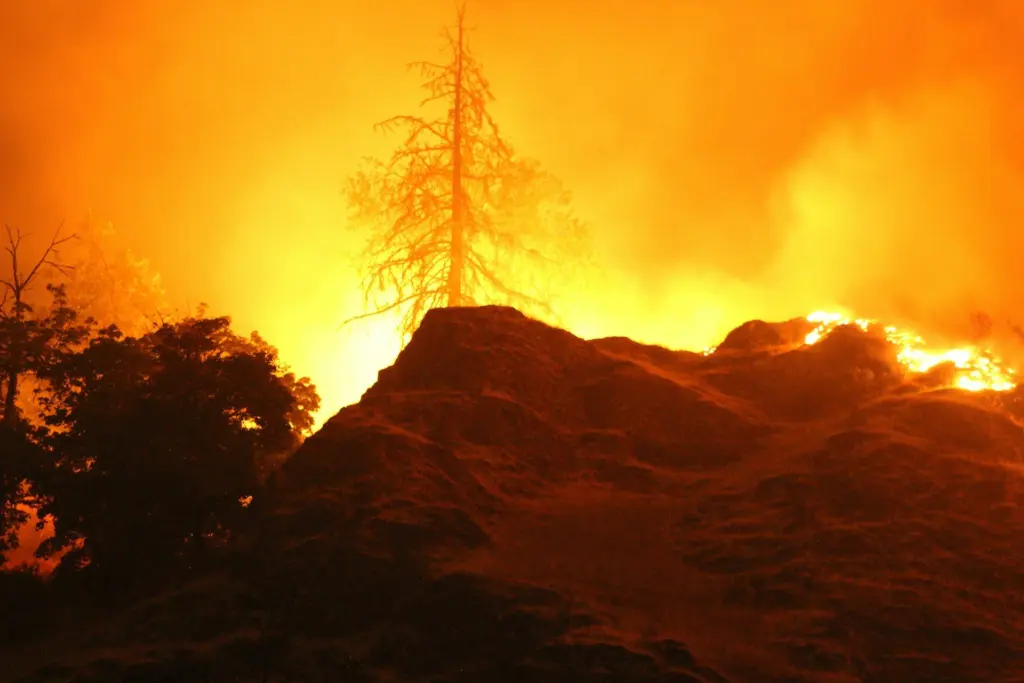SALEM, OR – Oregon’s statewide 2025 fire season officially wrapped Friday with significantly fewer acres burned at a lower cost to the state than in previous years.
But fires this year got much closer to communities, state fire officials said, burning 200 homes and structures. Many of those were in the Flat and Rowena fires near Sisters and The Dalles.
“From a purely acres burned standpoint, it was significantly less bad than last year. From a community impact and primary residences lost standpoint, it’s actually significantly worse than last summer,” said Kyle Williams, deputy director of fire operations at the Oregon Department of Forestry.
And humans caused most of this year’s fires.
Oregon experienced more than 1,100 fires from early June to mid-October. They burned roughly 350,000 acres, far less than the 1.9 million acres that burned in 2024.
Fires this year also cost the state less to fight — about $130 million for the state forestry department and $16.2 million for the Oregon State Fire Marshal’s Office. The department of forestry expects to receive $56 million in reimbursements from the federal government for helping with fires on federal land.
The 2024 fire season cost the state $350 million to fight and required a special session of the state Legislature to come up with the money.
Nearly 62% of the fires this year fought by the forestry department and the Office of the State Fire Marshal — more than 700 — were human-caused, according to Williams, despite a downward trend in recent years. Lightning caused about 30%. Those are both higher than the 10-year average for each kind of fire start.
Humans are the number one cause of wildfires in Oregon and across the country, but the proportion had been declining. In 2022, the share of fires caused by humans was down 20% from the state’s 10-year average.
Though less large-scale, there were roughly 100 more fires for state firefighters to tackle this year than last, which put the number of wildfires this season as a whole above the state’s 10-year average, according to forestry department data.
“I think it tells me that at the initial attack phase, we were incredibly busy this summer, but obviously the success rate was pretty darn good, right?” Williams said.
Forestry department firefighters stopped about 94% of the fires they handled before they grew beyond 10 acres, Williams said. That’s a target the U.S. Forest Service has set for nearly a century.’
The policy of keeping at least 90% of wildfires from growing larger than 10 acres has come under scrutiny by some indigenous wildfire and ecology experts and scientists, and even Forest Service scientists, who argue some wildfires must be allowed to burn more acres to help regenerate plants that support animal habitats, reduce pest infestation and invasive species and keep ecosystems healthy.
‘The great equalizer’
Last year, most wildfires in Oregon occurred in rangeland in central and eastern parts of the state. This year, forested areas took more of the heat.
Williams and Oregon’s Chief Deputy State Fire Marshal Travis Medema said the season got off with a worrisome start.
“I think Kyle and I might have even looked at each other at one point in June or July, and said, ‘Oh, man, we’re in for another 2024,’” Medema said.
By the numbers, the fire season was average for the number of “conflagrations” — a particularly large and destructive fire where state and regional coordination and aid are warranted. Gov. Tina Kotek declared eight of them throughout the summer, but six of those eight happened within about a month, from June 11 and July 14.
August rains in many parts of the state helped to keep smaller fires from growing into megafires.
“I think where that worked against us was in terms of the public sentiment around the risk,” Williams said. “People would say, ‘Oh, it rained seven, eight, nine days ago where I live,’ and we saw some poorly informed decision making and behavior potentially as a result of the edge of that risk being dulled just a bit.”
Federal agencies helped the state meet their needs and did a good job keeping fires contained on federal acres that make up half of Oregon, Williams said, despite fears that voluntary buyouts and cuts led by Elon Musk’s Department of Government Efficiency earlier this year would leave the federal wildfire fighting force shrunken.
“We always say weather is the great equalizer, no matter what. But the other piece of it was, from our perspective, the federal agencies were responding aggressively and in force when they had fires on their landscape,” Williams said.
Years of state fire agencies preparing and coordinating with local agencies and communities has helped, he added. So have hundreds of millions of dollars the state Legislature directed toward wildfire preparation and response since the 2020 Labor Day fires.
“We have had a decade-plus of having to learn how to catch up to our fire regime in this state,” Williams said. “And so as we did that, there’s been a lot of lessons learned in terms of that seamless just ‘get there quick and go’ part.”
Oregon Capital Chronicle is part of States Newsroom, a nonprofit news network supported by grants and a coalition of donors as a 501c(3) public charity. Oregon Capital Chronicle maintains editorial independence. Contact Editor Julia Shumway for questions: info@oregoncapitalchronicle.com.





